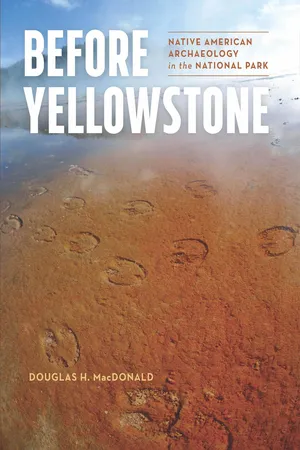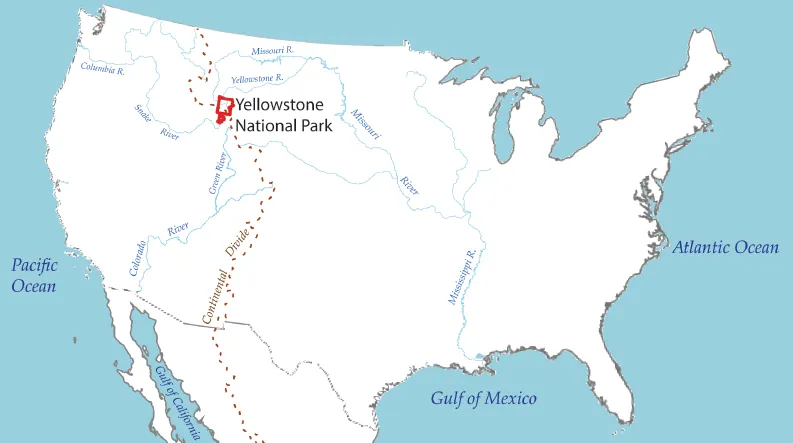![]()
FIGURE 1.1 Archaeologists look for Native American archaeological sites across all of Yellowstone National Park, including the northern mountains, to identify site locations so they can be protected and managed by the National Park Service.
CHAPTER ONE
YELLOWSTONE, PAST AND PRESENT
YELLOWSTONE NATIONAL PARK occupies a special place in the hearts of Americans as well as the rest of the world. As the first federally recognized national park, Yellowstone represents the ancient Wild West. With its well-known nickname, “Wonderland,” the park is considered a utopian landscape in the minds of many. Yellowstone is a singular place of untouched geothermal wilderness that strongly contrasts with the urban sprawl characterizing much of modern America. As if stepping back in time, travelers can venture along the winding roads and trails of Yellowstone and see exploding thermal geysers, wandering grizzly bears, herds of bison, and dramatic pristine landscapes.
Visitors to the park, especially those who arrive during the off-season, can feel like the first people who set foot there. The place has an eerie, quiet, prehistoric quality, despite the many modern developments since the park’s formation in 1872. Many travelers in Yellowstone do not know that humans have lived in the region for at least 11,000 years. Soon after half-mile-high glaciers melted and formed Yellowstone Lake during the Late Pleistocene era, early Native Americans made their way to Yellowstone, leaving behind spear points and bison bones that tell the stories of their lives there. These people likely arrived from northeast Asia, along the Pacific Coast, and up the Columbia and Snake Rivers, or they may have traveled from Alaska by way of a region between two giant glaciers that encompassed Canada.
FIGURE 1.2 The Grand Canyon of the Yellowstone River is a popular visitor attraction in the park.
In this book, I use archaeological research to paint a picture of the lives of Native Americans in the park for the previous 11,000 years. The book describes the Native American era before European contact, often referred to as the precontact, or prehistoric, period. The book also discusses how various Native American tribes used special places of the region, including mountains, rivers, geysers, and lakes. Starting with the first historic record of Obsidian Cliff in the 1870s by geologist and naturalist William Henry Holmes, scientists have continued to discover abundant material evidence of Native Americans in Yellowstone. Today, nearly 2,000 archaeological sites in the park dating from 11,000 to 100 years ago have been recognized, surveyed, and documented. This Native American precontact history in Yellowstone National Park is not well known to the general public.
MAP 1.1 Yellowstone National Park, within the United States
YELLOWSTONE, AMERICA’S FIRST NATIONAL PARK
Of the US national park system that now contains 59 preserved parks scattered throughout the United States, Yellowstone was the first. Since its founding in 1872, more than 150 million visitors have flocked to Yellowstone to witness its fascinating natural landscape and geothermal features. In 2015 alone, nearly 4.1 million tourists visited the park, most in the summer. Spring and fall are slower seasons with fewer visitors, while winter has even fewer. During any season, a short hike can quickly take you to areas where you will feel as if you are alone in the park. I’ve done this numerous times—always in groups of three or more, for safety regarding bears—and it always results in wonderful experiences. Almost anywhere in Yellowstone you will find unbroken ancient forests, amazing mountain vistas, and even archaeological sites used by Native Americans thousands of years ago. You just have to know how and where to look.
After California’s Death Valley National Park (at 3.4 million acres/1.4 hectares), Yellowstone—at 2.2 million acres (890,000 hectares)—is America’s second-largest national park in the Lower 48 states. There are six even bigger national parks by acreage in the continental United States, and they are in Alaska. Approximately 96 percent of Yellowstone National Park is in Wyoming, while 3 percent is in Montana and 1 percent in Idaho. Most of the center of the park—often referred to as the Yellowstone Plateau—is pushed upward in elevation by a vast geothermal bulge that marks the location of a large volcanic caldera. Because of this volcanism and the surrounding Rocky Mountains, more than 90 percent of the park is above 7,000 ft. (2,100 m) in elevation. The thin air at that altitude can be a shocker for many visitors whose homes are near sea level on the Atlantic or Pacific Coasts.
MAP 1.2 Yellowstone National Park
Yellowstone’s geothermal activity is also the cause of the park’s many thermal features, such as Old Faithful, which are popular among tourists in the central portion of the park. The lowest elevation in the park—about 5,300 ft. (1,600 m)—is near Gardiner, Montana, along the Yellowstone River, while the park’s highest mountains include Eagle Peak (11,372 ft./3,466 m) in the Absaroka Range in the eastern part of the park, as well as Electric Peak (10,969 ft./3,343 m) and the famous Mount Washburn (10,243 ft./3,122 m) in the northern tier of the park.
FIGURE 1.3 Old Faithful is one of Yellowstone’s most popular attractions. Even severe winter weather doesn’t stop the geothermal features of the park.
The natural setting of Yellowstone varies from those low-elevation areas in the Gardiner Basin of Montana to the high-elevation areas of Yellowstone Lake and the surrounding mountains. The Gardiner Basin in the northern part of the park, as well as the Madison River Valley in the western portion of the park, offer comparatively moderate winters and, therefore, refuge for bison, elk, deer, and pronghorn. These large animals seek the forage of the sagebrush prairies and grasslands in the lower elevations. In summer, they flock to the cooler higher elevations in central Yellowstone that are dominated by pine and spruce forests with scattered grassy meadows. Native Americans in the past followed a similar migration pattern, moving up in elevation in summer and down in elevation in winter. Their annual settlement patterns were oriented around the seasons, based on availability of food sources. With few resources available in the high-elevation, snowy uplands in winter, they sought the security of the valleys that surround Yellowstone National Park, including the Yellowstone, Snake, Madison, and Shoshone Rivers.
VISITING THE PARK
Just as the river corridors were the routes Native Americans traveled to and from the Yellowstone Plateau, they also are the major entry points to the park today. Visitors can enter Yellowstone National Park from five different entrances: the north (Gardiner, Montana, via the Yellowstone River Valley), the northeast (Cooke City, Montana, via the Lamar River Valley), the east (Cody, Wyoming, via the Shoshone River Valley), the south (Jackson, Wyoming, via the Snake and Lewis Rivers), and the west (West Yellowstone, Montana, via the Madison River Valley). Traveling through these river valleys—both in the past and in the recent times—brought people from the sagebrush grasslands up onto the heart of the Yellowstone Plateau, a lush, cool summer haven for Native Americans and modern visitors alike.
While more than 95 percent of Yellowstone is within the state of Wyoming, more than two-thirds of park visitors enter the park through the state of Montana. The West Yellowstone Entrance, in Montana, witnessed the most visitors in 2016—approximately 42 percent—followed by the South Entrance (20 percent), the North Entrance (19 percent), the East Entrance (13 percent), and the Northeast Entrance (6 percent).
The National Park Service operates Yellowstone and the other national parks through funding from the US Department of the Interior. The annual operating budget for Yellowstone is more than $30 million. Most of the park’s administrative offices are in the northern portion of the park in Mammoth Hot Springs, Wyoming. If you are visiting the park’s northern area, you will enter through the well-known North Entrance Arch in Gardiner, Montana. Gardiner is a small town of about 1,000 people. It has a variety of fine hotels, motels, and campgrounds that house many of Yellowstone’s tourists.
While the northern portion of the park around Gardiner is most popular in the summer, it is also one of the only portions of the park open year-round; most of the roads there are maintained throughout the winter in the park. Because of its comparatively low elevation, the Gardiner Basin is a winter retreat for large game, including bison, elk, and pronghorn antelope. Early Native Americans often spent portions of their winters in this valley around Gardiner as well.
FIGURE 1.4 My crew from the University of Montana conducted an archaeological survey in the sagebrush grasslands of the northern portion of Yellowstone near Gardiner, Montana (2007).
During our University of Montana archaeological expeditions near Gardiner between 2007 and 2009, my team and I identified dozens of important archaeological sites there that were used by Native Americans over the past 11,000 years (figure 1.4). This portion of the park is dry and largely covered by sagebrush grasslands along the winding Yellowstone River. The river offers abundant fishing and rafting opportunities for tourists.
Following the Grand Loop Road, the North Entrance road connects Gardiner, Montana, with Mammoth Hot Springs, Wyoming, some six miles south. The road passes a popular swimming hole—the Boiling River—just south of the Montana-Wyoming state line. A hot spring—with scalding water of above 130°F (54°C)—flows directly into the very cold water of the Gardner River, and the waters combine to provide a wonderful hot-tub-like experience in a roaring river setting. The Boiling River is closed in the spring because of high water conditions, but it is open the rest of the year. Native Americans lived along the Gardner River, leaving traces of their activities behind at numerous archaeological sites in the vicinity of Boiling River (elevation 5,700 ft./1,730 m). One of the most important Native American trails—the Bannock Trail—passed through this area. Used by the Shoshone, Bannock, Salish, and Nez Perce tribes, among others, this trail connected the Snake River region of Idaho to the west with the popular bison hunting grounds of the Great Plains east of Yellowstone.
FIGURE 1.5 After passing through the park’s North Entrance near Gardiner, Montana, visitors travel south on the Grand Loop Road along the Gardner River toward Mammoth Hot Springs. The Boiling River, where hot springs spill into the Gardner River, is a popular scenic spot.
Continuing southward, the Grand Loop winds up onto the vast Yellowstone Plateau. Approximately 1 mi. (1.6 km) along the winding highway, you come to Mammoth Hot Springs, Wyoming, at 6,350 ft. (1,930 m). Here, you will find the park’s administrative offices, a post office, a small medical clinic, as well as tourist lodging and restaurants. A tourist attraction here is the monumental Mammoth Hot Springs, which towers above the park facilities. There are numerous boardwalks where tourists can walk among the beautiful hot springs and terraces.
From Mammoth Hot Springs in winter, you can drive on the Grand Loop Road for 18 mi. (30 km) eastward to its intersection with the Northeast Entrance road at Tower Junction. On that road, you will pass a significant outcrop of chert—called Crescent Hill chert—which was collected and used by Native Americans. Chert is a highly siliceous rock that was popularly used throughout the world, including Yellowstone, by prehistoric people to make stone tools for survival. Yellowstone is rich with many sources of stone, including chert and obsidian, which provided raw material for tool making.
The Northeast Entrance road subsequently winds for about 30 mi. (48 km) along the Lamar River Valley to the park’s Northeast Entrance at Cooke City, Montana. The Lamar Valley is one of the park’s most popular areas to look for wolves, which often have dens in the foothills above. In a recent winter trip through this valley, my son and I watched a lone wolf compete for a bison carcass against a large grizzly bear and a pack of coyotes. The open sagebrush flats of the valley provide abundant grasslands for herds of...







